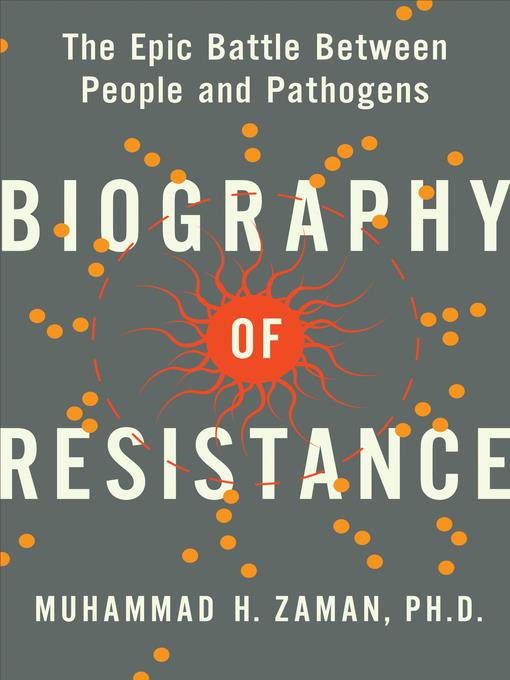
Biography of Resistance
The Epic Battle Between People and Pathogens
نبرد حماسی بین مردم و پاتوژنها
کتاب های مرتبط
- اطلاعات
- نقد و بررسی
- دیدگاه کاربران
نقد و بررسی

February 21, 2020
Bacterial drug resistance is a global public health threat evident in doctor waiting rooms: posters advising patients that they will not receive antibiotics unless medically indicated may seem odd until one realizes that patient demand (and medical personnel looking for a potentially easy fix) might mean an antibiotic prescription even if a need is not evident. Zaman (Howard Hughes Medical Inst. Professor of Biomedical Engineering and International Health, Boston Univ.) unravels a complex narrative through time and place of how bacteria around us has become drug resistant, whether by bacteria's own natural selection process or the effects of humanity on the natural world. Organized in short chapters loosely tied together by time, topic, or location, Zaman's work provides the full context of how bacteria resistance is nature at work and intrinsically linked to our futures. VERDICT Recommended for readers interested in the history of science and medicine, and how human response to global issues informs and impacts pathogen research and antibacterial use.--Rachel M. Minkin, Michigan State Univ. Libs., East Lansing
Copyright 2020 Library Journal, LLC Used with permission.

Starred review from March 1, 2020
A vivid portrayal of our fight against an opponent that has been around for more than 3 billion years. Zaman, a professor of biomedical engineering and international health, portrays a conflict--between humans and harmful strains of bacteria--that has played out in plagues and epidemics over millennia. That drama has now taken a turn for the worse with the rise of antibiotic resistance. In the U.S. alone, writes the author, more than 35,000 people die every year from drug-resistant infections. One of the primary causes is the overprescription of antibiotics and widespread use in industrial agriculture and livestock for prophylaxis and growth promotion. Bacteria mutate rapidly, and those that survive an antibiotic can pass their resistant genes to progeny as well as to other bacteria species. Indeed, one of Zaman's main points is that bacterial resistance is not new. Bacteria have been engaged in a Darwinian evolutionary competition among themselves since their origin. Samples of bacteria from a newly unearthed deep cave in the U.S.--and from the guts of an isolated tribe in Venezuela--contained bacteria that were resistant to a slew of contemporary antibiotics. The practice of modern medicine has upset a balanced equilibrium. Outside the U.S., antibiotic resistance is occurring where the drugs are available without a prescription and frequently used. They may also be adulterated or substandard and so further encourage antibiotic resistance to infections that are themselves the result of poor hygiene and sanitation. Using firsthand observations from around the world, the author presents many examples of disease outbreaks and the experts and efforts used to resolve them. These vignettes follow chapters that capture the history of bacteriology and the scientists working to fight bacterial resistance, highlighting the usual suspects--and not sparing the moral shortcomings of some. So what next? Despite continued antibiotic resistance and few drugs in the pipeline, Zaman is optimistic, citing new interest in phage therapy and experimental research funded by private foundations and other ventures. A compelling call to action demanding that governments and scientists rise to the challenge.
COPYRIGHT(2020) Kirkus Reviews, ALL RIGHTS RESERVED.

Starred review from February 15, 2020
Of the many catastrophes to fear, the increase and spread of antibiotic-resistant infectious diseases is high on the list. We take antibiotics, the wonder drugs of modernity, often and for granted. But bacteria mutate quickly, retooling their highly sophisticated, multilayered defense mechanism to repel antibiotic onslaughts, leading to a steady and terrifying rise in untreatable infections. Zaman, an award-winning professor of biomedical engineering and international health and a New York Times columnist, dramatically recounts the history of microbial research from the first magnified glimpse into the massive bacterial realm to the near-miraculous discovery of antibiotics to their commercial production and dissemination. Passionate about the science, the social implications, and the complex personalities of the scientists he so sharply portrays, Zaman reveals how the antibiotic saga of human ingenuity and greed is pegged to military conflicts, from WWI forward. Although resistance is increasing, the development of antibiotics by pharmaceutical companies has decreased, and dangerous antibiotic overuse medically and agriculturally is running rampant. Like those about global warming, warnings about the risk of antibiotic resistance and superbugs have been issued for decades with little action taken. Now the evidence, so vividly presented here, is overwhelming, and Zaman urges us to speak up.(Reprinted with permission of Booklist, copyright 2020, American Library Association.)

























دیدگاه کاربران